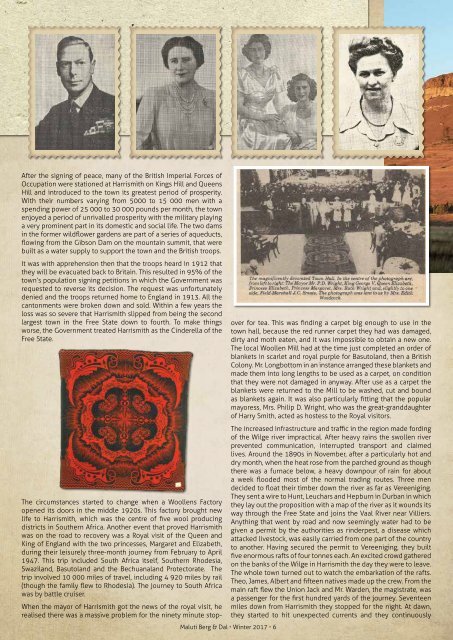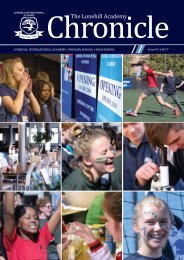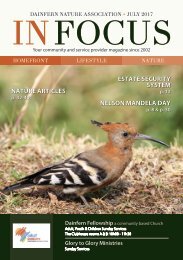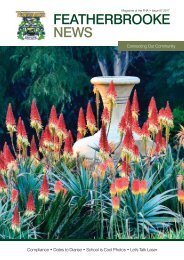Deckle Edge Media_Maluti_Issue 1 Winter 2017
Community magazine: From the hearts and homes in the Eastern Free State
Community magazine: From the hearts and homes in the Eastern Free State
You also want an ePaper? Increase the reach of your titles
YUMPU automatically turns print PDFs into web optimized ePapers that Google loves.
Crossroads<br />
After the signing of peace, many of the British Imperial Forces of<br />
Occupation were stationed at Harrismith on Kings Hill and Queens<br />
Hill and introduced to the town its greatest period of prosperity.<br />
With their numbers varying from 5000 to 15 000 men with a<br />
spending power of 25 000 to 30 000 pounds per month, the town<br />
enjoyed a period of unrivalled prosperity with the military playing<br />
a very prominent part in its domestic and social life. The two dams<br />
in the former wildflower gardens are part of a series of aqueducts,<br />
flowing from the Gibson Dam on the mountain summit, that were<br />
built as a water supply to support the town and the British troops.<br />
It was with apprehension then that the troops heard in 1912 that<br />
they will be evacuated back to Britain. This resulted in 95% of the<br />
town’s population signing petitions in which the Government was<br />
requested to reverse its decision. The request was unfortunately<br />
denied and the troops returned home to England in 1913. All the<br />
cantonments were broken down and sold. Within a few years the<br />
loss was so severe that Harrismith slipped from being the second<br />
largest town in the Free State down to fourth. To make things<br />
worse, the Government treated Harrismith as the Cinderella of the<br />
Free State.<br />
The circumstances started to change when a Woollens Factory<br />
opened its doors in the middle 1920s. This factory brought new<br />
life to Harrismith, which was the centre of five wool producing<br />
districts in Southern Africa. Another event that proved Harrismith<br />
was on the road to recovery was a Royal visit of the Queen and<br />
King of England with the two princesses, Margaret and Elizabeth,<br />
during their leisurely three-month journey from February to April<br />
1947. This trip included South Africa itself, Southern Rhodesia,<br />
Swaziland, Basutoland and the Bechuanaland Protectorate. The<br />
trip involved 10 000 miles of travel, including 4 920 miles by rail<br />
(though the family flew to Rhodesia). The journey to South Africa<br />
was by battle cruiser.<br />
When the mayor of Harrismith got the news of the royal visit, he<br />
realised there was a massive problem for the ninety minute stopover<br />
for tea. This was finding a carpet big enough to use in the<br />
town hall, because the red runner carpet they had was damaged,<br />
dirty and moth eaten, and it was impossible to obtain a new one.<br />
The local Woollen Mill had at the time just completed an order of<br />
blankets in scarlet and royal purple for Basutoland, then a British<br />
Colony. Mr. Longbottom in an instance arranged these blankets and<br />
made them into long lengths to be used as a carpet, on condition<br />
that they were not damaged in anyway. After use as a carpet the<br />
blankets were returned to the Mill to be washed, cut and bound<br />
as blankets again. It was also particularly fitting that the popular<br />
mayoress, Mrs. Philip D. Wright, who was the great-granddaughter<br />
of Harry Smith, acted as hostess to the Royal visitors.<br />
The increased infrastructure and traffic in the region made fording<br />
of the Wilge river impractical. After heavy rains the swollen river<br />
prevented communication, interrupted transport and claimed<br />
lives. Around the 1890s in November, after a particularly hot and<br />
dry month, when the heat rose from the parched ground as though<br />
there was a furnace below, a heavy downpour of rain for about<br />
a week flooded most of the normal trading routes. Three men<br />
decided to float their timber down the river as far as Vereeniging.<br />
They sent a wire to Hunt, Leuchars and Hepburn in Durban in which<br />
they lay out the proposition with a map of the river as it wounds its<br />
way through the Free State and joins the Vaal River near Villiers.<br />
Anything that went by road and now seemingly water had to be<br />
given a permit by the authorities as rinderpest, a disease which<br />
attacked livestock, was easily carried from one part of the country<br />
to another. Having secured the permit to Vereeniging, they built<br />
five enormous rafts of four tonnes each. An excited crowd gathered<br />
on the banks of the Wilge in Harrismith the day they were to leave.<br />
The whole town turned out to watch the embarkation of the rafts.<br />
Theo, James, Albert and fifteen natives made up the crew. From the<br />
main raft flew the Union Jack and Mr. Warden, the magistrate, was<br />
a passenger for the first hundred yards of the journey. Seventeen<br />
miles down from Harrismith they stopped for the night. At dawn,<br />
they started to hit unexpected currents and they continuously<br />
<strong>Maluti</strong> Berg & Dal • <strong>Winter</strong> <strong>2017</strong> • 6<br />
had to push themselves off the muddy banks with poles. By that<br />
afternoon they reached the crossing of the wagon road that came<br />
from Bethlehem and as there was no bridge at this point, there was<br />
a punt in operation. The heavy rafts were too heavy to manipulate<br />
at a moment’s notice, so the inevitable happened. Suddenly one<br />
of the natives shouted, “Baas, baas, Joseph is gone! We cannot find<br />
him!” With one casualty, a waterfall, two-day delay at Frankfort<br />
on the banks, a flash wave, and three months later they finally<br />
arrived in Johannesburg. When the station master asked whether,<br />
by spending a little money, it would be possible to use the rivers<br />
in future Theo laughed and answered, “No, a 1000 times no!”<br />
Certainly, he would never attempt that again!<br />
Presently, Harrismith is well known as an overnight or refreshment<br />
stop along the N3 route, but it has much more to offer. Beyond<br />
the highway is a tidy town with many elegant late nineteenth<br />
century buildings made of hewn sandstone. The beautiful tourist<br />
attractions include the Harrismith Town Hall, built in 1907; the<br />
former Drakensberg Botanical Garden (founded as a national<br />
botanical garden in 1967 but unfortunately now defunct);<br />
numerous trails and the Donkey Pass road to the Platberg summit<br />
and Platberg Reserve. Sterkfontein Dam, the third largest dam in<br />
South Africa, is located just outside of the town. Built before the<br />
Lesotho Highlands Water Project was developed, this was a vital<br />
source of water for Gauteng. It is ideal for water sport enthusiasts<br />
and anglers. The scenic 18-hole Harrismith Golf Course, which<br />
is arguably the third oldest in South Africa (after the Royal Cape<br />
and George Golf Clubs), was founded in 1887. Kerkenberg is<br />
the historical place where the Voortrekkers camped while their<br />
leader, Piet Retief, descended into KwaZulu-Natal to negotiate for<br />
land with the Zulu chief Dingane. Retief’s daughter painted her<br />
father’s name and recorded the date, which was also his birthday,<br />
on the rock where they held a church service. Beautiful Bushmen<br />
Rock Art can be found at Tandjiesberg, only five kilometres out<br />
of town. Harrismith is the best access point to the northernmost<br />
Drakensberg, including the Tugela Falls and Mont-Aux Sources<br />
“Today we are proud to have companies<br />
like Nouwens Carpets that opened its doors<br />
during the early fifties, Nestlé, Nampak and<br />
Highway Junction ...”<br />
Photos on this spread: Opposite page top left to right: H.M. The King, H.M. The Queen, Royal Princesses, Mrs Wright, daugther of Sir Harry Smith,<br />
Newspaper climping about the “Royal” Blanket, (bottom left) image of the “Royal” Blanket. Above: Platberg - by JMK (Wikimedia.org) / Harrismith<br />
Town Hall (Souvenir Programme – Royal visit to Harrismith).<br />
<strong>Maluti</strong> Berg & Dal • <strong>Winter</strong> <strong>2017</strong> • 7<br />
south of Harrismith on the R57, the Drakensberg World Heritage<br />
Site (66 kilometre southeast via Oliviershoek Pass beyond<br />
Sterkfontein Dam) and the spectacular Golden Gate Highlands<br />
National Park (50 kilometres south of the town on the R712).<br />
Today we are proud to have companies like Nouwens Carpets<br />
that opened its doors during the early fifties, Nestlé, Nampak and<br />
Highway Junction – which is home to the largest truck stop in the<br />
Southern Hemisphere. Harrismith also boasts its own local airstrip.<br />
During our annual Berg Bohaai Festival (literally translated from<br />
Afrikaans it means “mountain mania”) we have two very popular<br />
races: the Dirty Harry and the Platberg Mountain Race. The latter<br />
is a 15 kilometre foot race, described as the “toughest marathon<br />
in the world” by Wally Hayward. It originated in 1922 when a<br />
British soldier, Major A. E. Belcher, returned to Harrismith from<br />
where he had been stationed near 42nd Hill during the Second<br />
Anglo Boer War. He referred to Platberg as “that small hill of<br />
yours” when he would talk to the locals, and one of the locals<br />
immediately bet him that he could not reach the top in less than<br />
60 minutes. Belcher accepted the challenge and covered the<br />
distance with eight minutes to spare. Afterwards Major Belcher<br />
presented a floating trophy to be awarded as a prize for the first<br />
athlete to reach the top of the mountain. The record time today is<br />
22 minutes and 9 seconds.<br />
Three other places in the world bear the same name: Harrismith<br />
Beach and Harrismith House near Bottom Bay in Barbados, and<br />
Harrismith in the Wheat belt region of Western Australia.<br />
...........................................................................................................................................<br />
Sources<br />
And not to yield – Penelope Matthews<br />
Souvenir Programme – Royal visit to Harrismith<br />
Harrismith News – March 15th 1947, <strong>Issue</strong> No. 2246<br />
https://en.wikipedia.org/wiki/Harrismith





